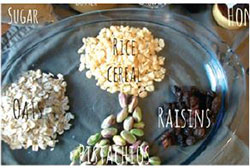Pistachios: A Small But Mighty Nut
Anne Zander, CSU Extension FCS Agent, Boulder County
 |
| Photo by Emily Liu |
FUN FACTS ABOUT PISTACHIOS:
- Pistachios are known as the “smiling nut,” “happy nut,” and the “green almond.”
- Humans have eaten pistachio nuts for at least 9,000 years.
- Thanks to their high nutritional value and long storage life, pistachios were a key travel food among early explorers and traders, and an ingredient in the first trail mix!
- Pistachios are a good source of fiber, providing 3 grams per serving. That’s more than many types of whole fruit. A serving size is one ounce, which is equal to about 40-50 nuts.
- In America, pistachios were once dyed red to disguise shell imperfections and make the nuts stand out in vending machines.
Nutrition Facts
Pistachios are one of the few nuts that contain many nutrients required by humans to maintain their overall health. Pistachios are a good source of protein and fiber and an excellent source of healthy fats. Pistachios contain a lower calorie content compared to other nuts, containing only 160 calories per one ounce.
Pistachios contain a higher amount of protein and fiber in comparison with other nuts such as almonds,
cashews, hazelnuts, macadamias, pecans, and walnuts. Pistachios contain 6 grams of protein per 1 ounce, which
can help you feel full and satisfied.
The fat content is the lowest compared to the other nuts. Fat content is 13 grams per 1 ounce. Although we need healthy fats in our diet, remember to consume in moderation. They are high in monounsaturated fatty acids and polyunsaturated fatty acids, helping to lower “bad” LDL cholesterol and increase “good” HDL cholesterol.
Out of all the nuts, pistachios have the highest amount of antioxidants, and even rank higher than green tea.
Compare how much is an ounce?
|
|
Safety
- Any family members that are known to be allergic to nuts should not consume them. The reaction symptoms may range from simple skin itching (hives) to life threatening anaphylactic shock, including breathing difficulty, stomach pain, vomiting, and diarrhea.
Easy ways to add to your diet
- Measure 1 ounce of nuts into individual bags or containers for quick snacks.
- Sprinkle nuts on your cereal, yogurt, fruit, vegetables, salads, or pasta dishes.
- Add nuts to the batter when making muffins, pancakes, cookies, cakes, breads, and brownies.
- Try nut-encrusted fish or chicken.
Purchasing and Storing pistachios
- You may buy them with the shell on or already shelled. Sometimes buying nuts in their shells can help with portion control since it takes time to shell them.
- Closed shelled pistachios are immature and may taste bitter.
- Salt, pepper, and sweet chili are common seasonings added to pistachios. Unsalted pistachios are also available for those needing to limit sodium intake.
- Shelf life can be up to 24 months, when stored between 65-70 degrees Fahrenheit. To keep crunchy and great tasting, store them in an airtight container.
Let’s Talk
February 26 is National Pistachio Day, providing a great reason to introduce your family to the nutritious little nut. When you encounter the pistachio nut that is just barely open, the first instinct is to use your fingernails to pry it open, crunch it with your teeth. But show your child how to resist those urges and use this handy trick in order to avoid risking sore fingernails or broken teeth!
Step 1: Use the Right Tool for the Job – Grab a discarded ‘pistachio nut shell half ’, and stick the top of the small end into the partially-opened pistachio.
Step 2: With the shell top inserted into the crack, twist the shell half like you would turn a screwdriver. Clockwise or counterclockwise
directions both work equally well. As your child twists, the shell will separate as if by magic.
Step 3: Victory! Your child has beaten the pistachio at its own game, and now can enjoy the prize.
Recipes for Health:

Homemade Pistachio Granola Bars
Ingredients:
- 2 cups of old fashioned oats
- 1 cup of breakfast rice cereal (optional)
- 1/2 cup pistachios, chopped (un-salted)
- 1/2 cup raisins
- 1/2 cup peanut butter
- 1/2 cup brown sugar
- 1/4 cup honey
- 1/2 cup unsweetened apple sauce (optional – add for a more moist bar)
Directions:
- Roughly chop pistachios by hand or with a food processor.
- Combine oats, rice cereal (optional), pistachios and raisins into a large bowl.
- In a microwave safe bowl combine peanut butter, brown sugar, applesauce and honey. Then microwave on high for 1 and 1/2 minutes.
- Remove from the microwave and pour the peanut butter mixture into the large bowl with the dry ingredients.
- Mix thoroughly making sure every bit of dry ingredient is covered with the peanut butter mixture.
- Pour the mixture into an 8×10 baking sheet, press down into pan and let cool before covering with plastic wrap. You can also roll them into balls, shape them into bars or cut them into fun shapes!
Recipe: Michigan State University Extension
Nutrition per 2”x2” granola bar: 116 calories, 5 g. total fat, 0.7 g. saturated fat, 39 mg. sodium, 17 g. carbohydrates, 3 g. protein
Additional Resources:
Recipes from the American Pistachio Growers – http://americanpistachios.org/recipes-and-snacking
Pistachio Health Institute – http://www.pistachiohealthinstitute.org/consumer
CSU Extension – Live Eat Play http://www.liveeatplay.colostate.edu/eat/nutrition101/foods-a-z/pistachios.php





